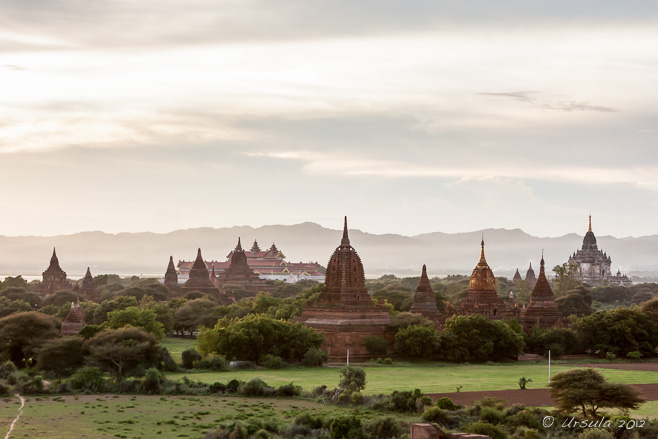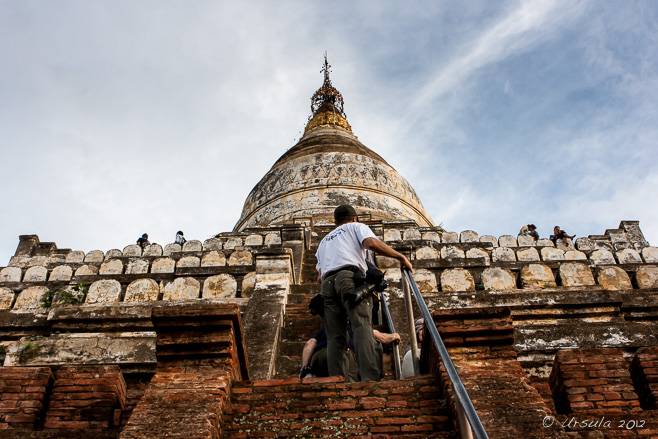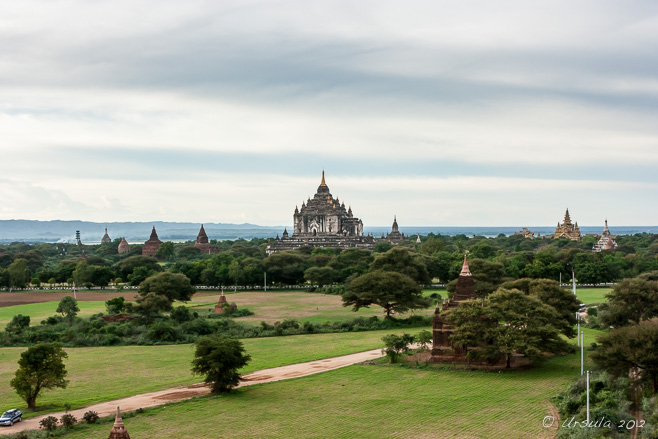
Looking over Bagan at Twilight
It’s a landscape with soul and atmosphere – no matter how many pictures one sees, there is nothing like being there.
What an amazing place Bagan must have been in its heyday!
“Bagan is a gilded city alive with tinkling bells and the swishing sounds of monks’ robes”
– attributed to Marco Polo‘s late-12th-century account.
Probably founded in the mid-to-late 9th, the city was the political, economic and cultural capital of the Pagan Empire for 250 years, and would have been at its height when Marco Polo saw it. A prosperous cosmopolitan city, it was a centre for religious and secular studies, attracting monks and students from as far as India, Ceylon and the Khmer Empire (Wikipedia).
“It is estimated that as many as 13,000 temples and stupas once stood on this 42 sq km plain in central Myanmar…” The Pagan Empire collapsed in 1287 after repeated Mongol invasions, leaving the sacred buildings almost empty, except as destinations for pilgrims. Many less-visited sites fell into ruin. Continual earthquake activity – over 400 earthquakes were recorded between 1904 and 1975 alone – has caused further collapse. Of the estimated original 1000 stupas, 10,000 small temples, and 3000 monasteries, only about 2200 temples and pagodas remain in various states of disrepair.
Those remaining buildings, however, are magic. They belong. They grow out of the flat plains beside the Ayeyarwady (Irrawaddy) River organically. The air is hot and dusty, making the whole scene surreal.

Climbing Shwesandaw Pagoda
In the heat of the afternoon we climb the steep steps of the classic “sunset temple”, where tourists gather every evening to watch the sun go down over the Bagan Plains.
Nothing prepared me for my first view over the extensive Bagan Plains, as I, nine colleagues, photographer Karl Grobl, local guide Mr MM, and countless local and international tourists, looked for optimal positions on one of the five tiers of the Shwesandaw Pagoda. Built by King Anawrahta in 1057, this is now a popular “sunset temple” because of its central location, affording 360° outlooks over the ruins.

Thatbyinnyu Temple
Between us and the distant Ayeyarwady (Irrawaddy) River, the Thatbyinnyu Temple stands out to the north. The tallest of the pagodas, it was built in the 12th century.

Sulamani Temple
Sulamani Temple, built in 1183 by King Narapatisithu, sits to the east of us amid the arid, dusty fields of Minnanthu.

Bagan
Stupas dot the landscape all around.

Looking over Bagan
I had carried my tripod across three continents so it would be with me on this trip. I’d humped it on and off buses and planes, and lugged it up the steps of Shwesandaw Pagoda – only to discover that a vital part had somehow gone missing and it was useless to me. It was a bit humbling, therefore, to notice that not everyone brings even a camera.

Newlyweds
Bagan is still a pilgrimage site and a special place for Burmese, like this newlywed couple.

Dhammayangyi Temple
Darkening skies loom over the incomplete Dhammayangyi Temple, which itself has a dramatic history. The largest of the temples, it was commissioned by King Narathu to atone for his sins of assassinating his father, brother, and wife. The story goes that he also had a bricklayer put to death because the tradesman’s work was not good enough. Building on the temple stopped when the King himself was murdered.

Stillness
A visiting monk takes in the scene.

Ananda Temple
Bagan’s holiest temple, Ananda, or “boundless wisdom”, was built by king Kyan-zit-tha in 1091.

Bagan
The stupas and their surrounds are constantly changing colour in the lowering light. The dry climate has helped preserve the essential structures, but wind and dust have scraped away the original stucco coatings, leaving the graceful brickwork exposed.

Pony Carts
Pony carts and tour buses wait at the bottom of the temple steps.

Falling Light
As the evening light falls, the mists rise on the Ayeyarwady River and the temples start to disappear into the trees and mountains.

Tender Pinks
Pink and blue evening skies replace the grey …

Pink Sky
…over Dhammayangyi Temple.

Layers
Temples, trees, mountains and clouds layer into the distance.

Bagan Skyline
As the day ends, temples are silhouetted against the darkening sky.

Under Lights
We resort to flashlights to make our way back down the the steps of Shwesandaw Pagoda as darkness falls all around. In the distance, Ananda Temple is flood-lit against the night sky.
 It is a magic place, and it was hard to leave – but fortunately, we were coming back the next day. I couldn’t wait!
It is a magic place, and it was hard to leave – but fortunately, we were coming back the next day. I couldn’t wait!
Till next time,
Happy Travels!
Pictures: 17September2012





















.png)
.png)


for me an amazing serie, I have nice and pretty memories when I see your report. Ursula, warm greeting from Holland, Dietmut
Awesome post! Ursula, you do a fantastic job with your images and your words! Thanks for sharing with us…it’s awesome to relive the experience through your eyes and thoughts. Wow!
Dietmut, I’m always pleased to bring you good memories!
Karl, thanks so much for your “visit” and praise. I hope MM is enjoying the tripod! 😀
[…] all its temples, however, are ruined relics of the Pagan Empire (9th to 13th Century). Others – like the beautiful Shwezigon Pagoda – are still living, breathing […]
[…] magnificent, pagoda-studded plains of Bagan (A Living Landscape) sit in a curve in the Irrawaddy (Ayeyarwady) River, in a rain shadow between the low coastal […]
[…] said it before (A Living Landscape) – Bagan is a magic […]
Amazing photos taken during the sunset! Bagan has so many spots to take great photos both for the sunrise (of course from the balloons) and sunet!